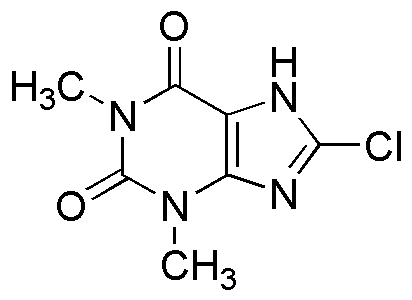8-Chlorotheophylline is widely utilized in research focused on:
- Pharmaceutical Development: This compound serves as a valuable intermediate in the synthesis of various pharmaceuticals, particularly those targeting respiratory conditions, enhancing drug formulation efficiency.
- Research on Caffeine Metabolism: It is used in studies investigating the metabolism of caffeine and its effects on human health, providing insights into dietary impacts and potential therapeutic uses.
- Analytical Chemistry: 8-Chlorotheophylline is employed as a reference standard in analytical methods such as HPLC, aiding researchers in the accurate quantification of related compounds in complex mixtures.
- Botanical Studies: This compound is utilized in botanical research to explore the effects of chlorinated purines on plant growth and development, contributing to agricultural science.
- Neuroscience Research: It is investigated for its potential neuroprotective effects, offering possibilities for developing treatments for neurodegenerative diseases.
General Information
Properties
Safety and Regulations
Applications
8-Chlorotheophylline is widely utilized in research focused on:
- Pharmaceutical Development: This compound serves as a valuable intermediate in the synthesis of various pharmaceuticals, particularly those targeting respiratory conditions, enhancing drug formulation efficiency.
- Research on Caffeine Metabolism: It is used in studies investigating the metabolism of caffeine and its effects on human health, providing insights into dietary impacts and potential therapeutic uses.
- Analytical Chemistry: 8-Chlorotheophylline is employed as a reference standard in analytical methods such as HPLC, aiding researchers in the accurate quantification of related compounds in complex mixtures.
- Botanical Studies: This compound is utilized in botanical research to explore the effects of chlorinated purines on plant growth and development, contributing to agricultural science.
- Neuroscience Research: It is investigated for its potential neuroprotective effects, offering possibilities for developing treatments for neurodegenerative diseases.
Documents
Safety Data Sheets (SDS)
The SDS provides comprehensive safety information on handling, storage, and disposal of the product.
Product Specification (PS)
The PS provides a comprehensive breakdown of the product’s properties, including chemical composition, physical state, purity, and storage requirements. It also details acceptable quality ranges and the product's intended applications.
Certificates of Analysis (COA)
Search for Certificates of Analysis (COA) by entering the products Lot Number. Lot and Batch Numbers can be found on a product’s label following the words ‘Lot’ or ‘Batch’.
*Catalog Number
*Lot Number
Certificates Of Origin (COO)
This COO confirms the country where the product was manufactured, and also details the materials and components used in it and whether it is derived from natural, synthetic, or other specific sources. This certificate may be required for customs, trade, and regulatory compliance.
*Catalog Number
*Lot Number
Safety Data Sheets (SDS)
The SDS provides comprehensive safety information on handling, storage, and disposal of the product.
DownloadProduct Specification (PS)
The PS provides a comprehensive breakdown of the product’s properties, including chemical composition, physical state, purity, and storage requirements. It also details acceptable quality ranges and the product's intended applications.
DownloadCertificates of Analysis (COA)
Search for Certificates of Analysis (COA) by entering the products Lot Number. Lot and Batch Numbers can be found on a product’s label following the words ‘Lot’ or ‘Batch’.
*Catalog Number
*Lot Number
Certificates Of Origin (COO)
This COO confirms the country where the product was manufactured, and also details the materials and components used in it and whether it is derived from natural, synthetic, or other specific sources. This certificate may be required for customs, trade, and regulatory compliance.


